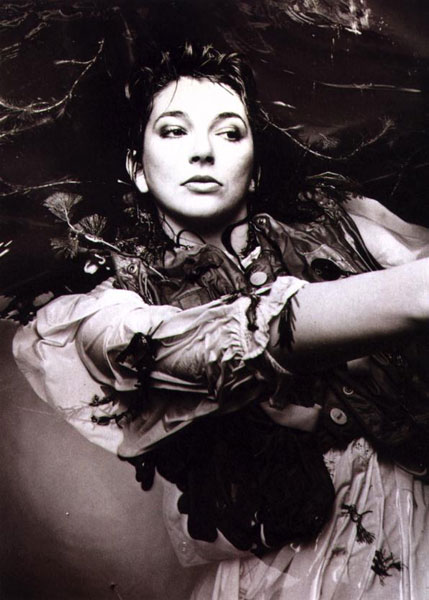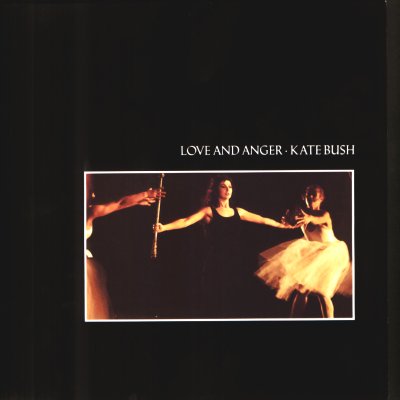Movies 2005: "Not My
Blood!"
Love and Anger
Review by John Demetry
Part I: The Battle of the
Bushes
Armond White’s annual
presentation of the best in recent music video art lived up to its
paradoxical-poetic title: "Music to My Eyes." He closed the evening –
the year’s peak for art-discovery – with a video from the past to
exemplify the
themes and achievements of music videos present (and Movies 2005, in
general).
That work of art: the 1990 music video – Love and Anger –
directed by
(and featuring the song by) Kate Bush.
Only the divisive bugaboo
constructed – through the exploitation of contemporary Anger and
stifled need
to Love – around another Bush (George W.) stands in the way of feeling
and
applying the achievement of this video and song. Kate Bush and her
images sing
directly to the pain prevalent in the contemporary culture. She
fulfills the
duty of the poet.
To quote Paul Murray, OP,
in his essay "The Fourth Friend: Poetry in a Time of Affliction" in
the latest issue of Logos:
"By naming, through poems
and stories, the black stone of affliction – the stone that had no
name,
perhaps, but that weighed heavily on our hearts – the weight of the
stone is
somehow lifted. We are touched by God’s grace, and healing begins."
Murray suggests the
social-spiritual genesis of the great pop hope that Bush miraculously
realizes
with Love and Anger. (I think it might be the greatest music
video I’ve
ever seen.)
 Love and Anger addresses the audience with the
healing – transmogrifying, redemptive, and revolutionary – force of pop
experience. The video ends with Bush on stage with her rollicking band.
She
throws glitter into the camera. It constitutes a baptism – danceclubs!
disco!
punk! glam! rock concerts! youth rebellion! sexual experimentation!
gender-bending! – inducting the audience into a new social potential, a
pop
community. It turns out to be the definitive post-postmodern gesture.
(Music to
my eyes, indeed.)
Love and Anger addresses the audience with the
healing – transmogrifying, redemptive, and revolutionary – force of pop
experience. The video ends with Bush on stage with her rollicking band.
She
throws glitter into the camera. It constitutes a baptism – danceclubs!
disco!
punk! glam! rock concerts! youth rebellion! sexual experimentation!
gender-bending! – inducting the audience into a new social potential, a
pop
community. It turns out to be the definitive post-postmodern gesture.
(Music to
my eyes, indeed.)
Post-postmodern: Following
the liberation of the "sign" in the postmodern era came the
profoundly expressed need to redefine community and spirituality, to
revitalize
the "sign" through a radical conception of faith. The media curtails
this evolution (occurring at the vital base of the culture) from
entering into
the mainstream (and academia).
Fearlessly, Bush offers the
blessing of glitter and dance: vernacular means of celebration (and
photogenic,
no less). Love and Anger begins with Bush isolated. A spotlight
defines
the limits of her space – a circle of light etched on the stage. This
staging
illuminates the means of her physical expression, her face and body –
dressed
in a black leotard. In the pose of prayer – contemplation and humility
– a
shower of glitter falls on Bush as she sings/intones/moves:
"It lay buried here /
It lay deep inside me / It's so deep I don't think that I can speak
about
it"
That glitter signifies so
much – and it falls upon pop (music, film, music video) artists 2005
like Peter
Pan’s fairy dust (pace the national/pop-cultural quest Bush outlined in
her
song "In Search of Peter Pan"). The glitter crystalizes the central
theme and challenge of movie-going 2005 (self-definition through
capacity for
empathy, for aesthetic engagement):
1. It gives form to the
dazzling light of an individual, of a soul.
2. That spiritual core –
the essence of personality, of humanity – is witnessed in relation to
the
social and the cosmic.
3. The spiritual reveals
itself in relief to essential innocence and the experience of grace.
4. The presence of grace is
understood through shared expression – a delight in beauty upon which
community
is formed and through which healing is performed.
Without the profound
humility Bush displays here, one cannot get outside oneself to see
oneself. As
she sings variations on the following chorus, Bush expands the space
(and the
tropes) to include troupes performing Western and Eastern forms of
dance:
"Two strings speak in
sympathy / What would we do without you? / Take away the love and the
anger /
And a little piece of hope holding us together"
During the early renditions
of this refrain, Bush displays the Sovereign Scepter and Orb – the
historical-religious symbols of her beloved "Lionheart," England. In
a powerfully generous (and liberating) gesture, Bush extends across the
frame
these totems of royalty (a sentiment later enlarged in the offering,
from the
stage, to the spectator at the end of the video). Bush relinquishes
these
symbols – from faith to faith – to the dancers: "A little piece of hope
holding us together." This moment in Love and Anger proves as
awesome as the compassionate gesture (society’s neglected - an artist -
confronts the floating head from John Boorman’s Zardoz) in
Justin
Pandolfino’s music video: Dreams. (I’ll say it again: "The Land
and
the King are one" – Excalibur.)
Consequently, Bush opens those
wide eyes of experience and hope (mirrored across time to Tom Cruise
and Dakota
Fanning – agape – in Steven Spielberg’s 2005 War of the Worlds).
She
revs up to an energetic dance – what White compares to Pentecostal
ecstasy.
Further expanding the multi-cultural sources of her pop expression, an
inspired
Bush takes to the stage with her band. Bush executes another extension
of space
(a philosophical leap), from individual to communal celebration. Bush
takes
advantage of music video’s pop base (the song!) to make this meta shift
in the
mis-en-scene. The literal process of music-making becomes, itself,
another
metaphor. Doing so, she concretizes the process behind the sonic
element of the
call-and-response ("Two strings speak in harmony"). The dancers
dramatized
the support of an East-West beloved community during the chorus.
Glitter is everywhere.
Check out the significance
of these dance steps:
1. Individual pain is
defined by the spotlight and Bush’s movement – and then recognized by
that
distinctive voice (note the song’s move from "I" to the universal,
yet intimate, "you").
2. The symbols that reveal
and ameliorate that pain are identified within the individual’s
heritage (the
scepter and orb): embraced and shared (metaphorical gestures).
3. The universal expression
of dance reveals the process of healing, the revelation of beauty, as a
cross-cultural one, communal and artistic (political and religious).
4. Bush’s wild festivity
on-stage with her bandmates leads spectator savvy to a pop revelation –
baptizing
the audience in glittered possibility.
Through the sensitivity
engendered by personal torment, Bush celebrates the presence of grace
in pop:
"Don't ever think that
you can't change the past and the future / You might not, not think so
now, /
But just you wait and see – someone will come to help you"
In the context of the
video, that "someone"represents the artist – specifically the pop
artist – drawing upon resonant rituals of perseverance and unifying
symbols.
Thus, "someone" represents the cultures of the world that offer the
surprise of continuity in experiences, striving through creativity.
Such
discovery inspires the artistic (curious, openhearted) mind.
"Someone" can also refer to a "friend" who provides
compassion and sympathy – "a deeper understanding." God – the great
"someone" – inspires "artist" and "friend" alike:
that is the truth revealed by the phenomenon (undeniable!) of shared
understanding. Bush defines the post-postmodern by inspiring audiences
to take
the imaginative trek through the end of contemporary sophistication to
pop
faith.
The other day, I saw a
t-shirt worn by a New Yorker. It featured a picture of President George
W.
Bush. The caption read: "The reason I will never vote again." It
signifies phony "liberty": the appropriation of the symbolic
figurehead of the nation (the President) to justify a cynical dismissal
of
ritual participation. It amounts to one’s willing exploitation. The
relinquishment of citizenship, a betrayal of the democratic dream,
represented
by that t-shirt establishes "power" as the basis of value. What is
citizenship but the enactment of one’s spiritual potential?
George W.
Bush, Fox News, The New York Times, and The Village
Voice
benefit equally from the culture’s abandonment of faith.
Every person experiences
the truth of grace in the existential quandaries of life, in the desire
for
intimate relations. Only Kate Bush’s pop baptism of glitter, however,
can
inspire the audience to extrapolate the truth of that experience into a
relationship with art, politics, and Love. Reflecting the light of
Bush’s
glitter, Movies 2005 attempt to restore our lost faith. Through these
artworks,
one repeats Bush’s philosophical – post-coital! – affirmation at the
end of Love
and Anger: "Yeah!"
Experience that special joy
with the film reviewed in a piece coming soon: Gael Morel’s beyond
magnificent Le clan (a.k.a. Three Dancing Slaves).
Pictures:
from the top:
Kate Bush
(EMI)
 Love and Anger addresses the audience with the
healing – transmogrifying, redemptive, and revolutionary – force of pop
experience. The video ends with Bush on stage with her rollicking band.
She
throws glitter into the camera. It constitutes a baptism – danceclubs!
disco!
punk! glam! rock concerts! youth rebellion! sexual experimentation!
gender-bending! – inducting the audience into a new social potential, a
pop
community. It turns out to be the definitive post-postmodern gesture.
(Music to
my eyes, indeed.)
Love and Anger addresses the audience with the
healing – transmogrifying, redemptive, and revolutionary – force of pop
experience. The video ends with Bush on stage with her rollicking band.
She
throws glitter into the camera. It constitutes a baptism – danceclubs!
disco!
punk! glam! rock concerts! youth rebellion! sexual experimentation!
gender-bending! – inducting the audience into a new social potential, a
pop
community. It turns out to be the definitive post-postmodern gesture.
(Music to
my eyes, indeed.)